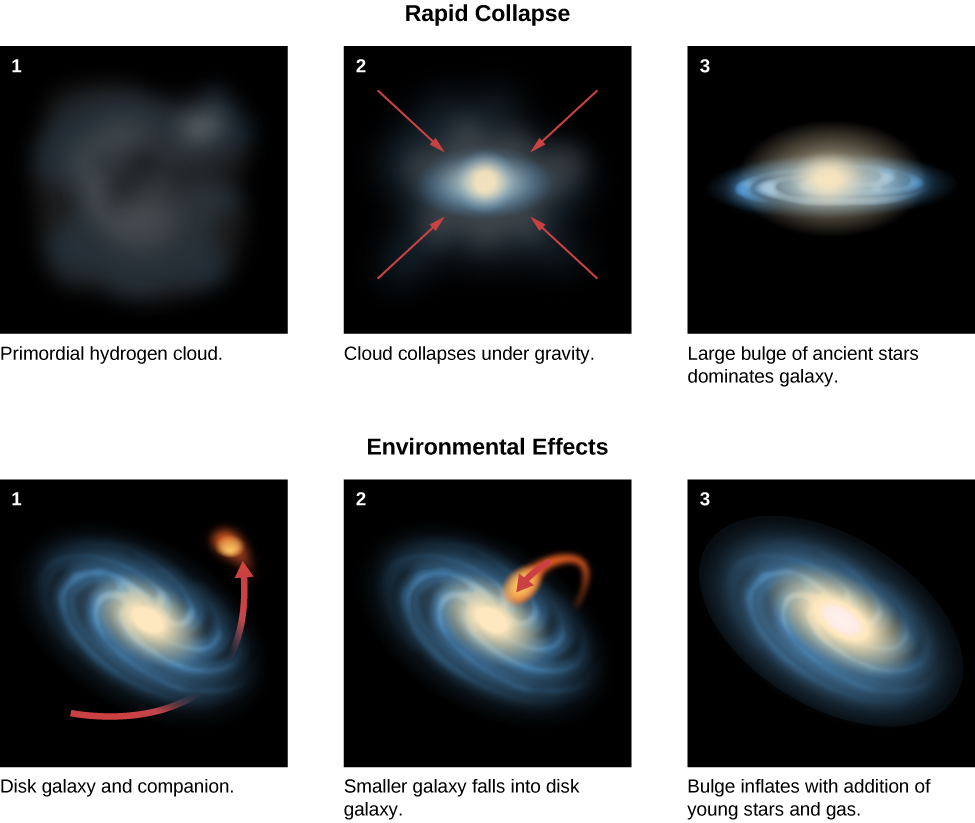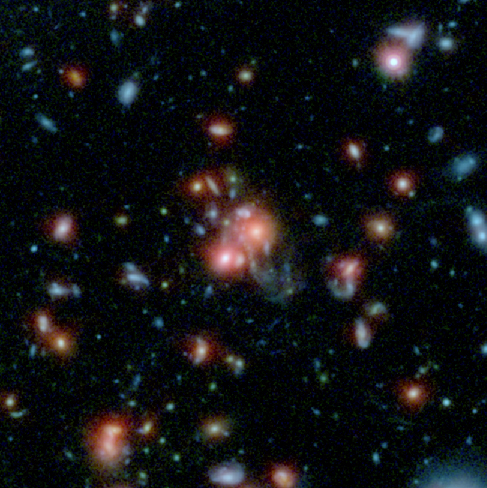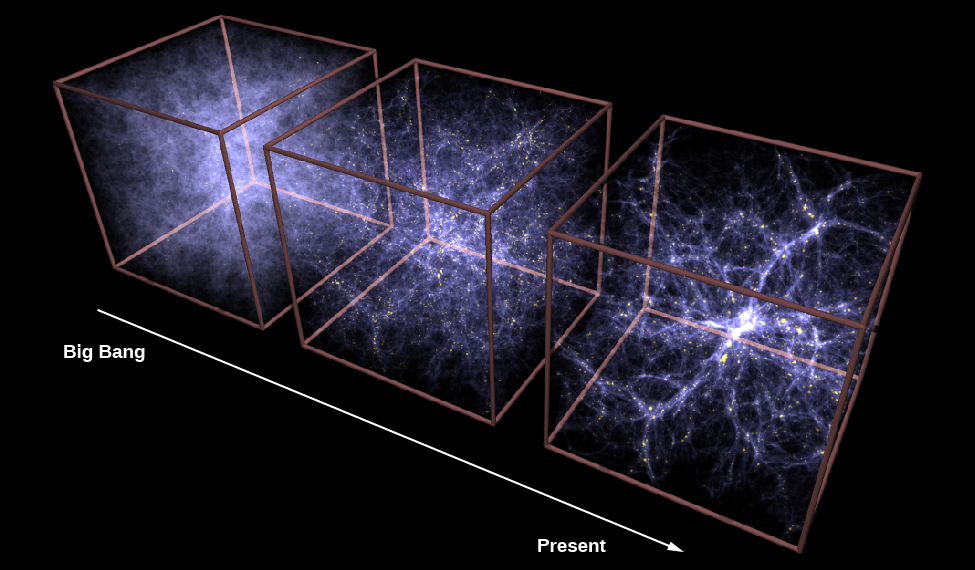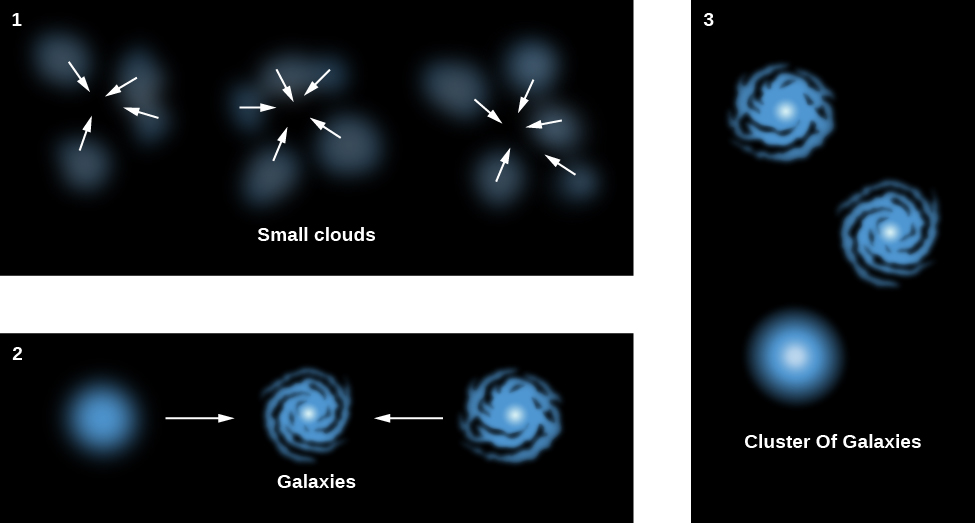Chapter 28 The Evolution and Distribution of Galaxies
28.5 The Formation and Evolution of Galaxies and Structure in the Universe
Learning Objectives
By the end of this section, you will be able to:
- Summarize the main theories attempting to explain how individual galaxies formed
- Explain how tiny “seeds” of dark matter in the early universe grew by gravitational attraction over billions of years into the largest structures observed in the universe: galaxy clusters and superclusters, filaments, and voids
As with most branches of natural science, astronomers and cosmologists always want to know the answer to the question, “How did it get that way?” What made galaxies and galaxy clusters, superclusters, voids, and filaments look the way they do? The existence of such large filaments of galaxies and voids is an interesting puzzle because we have evidence (to be discussed in The Big Bang) that the universe was extremely smooth even a few hundred thousand years after forming. The challenge for theoreticians is to understand how a nearly featureless universe changed into the complex and lumpy one that we see today. Armed with our observations and current understanding of galaxy evolution over cosmic time, dark matter, and large-scale structure, we are now prepared to try to answer that question on some of the largest possible scales in the universe. As we will see, the short answer to how the universe got this way is “dark matter + gravity + time.”
How Galaxies Form and Grow
We’ve already seen that galaxies were more numerous, but smaller, bluer, and clumpier, in the distant past than they are today, and that galaxy mergers play a significant role in their evolution. At the same time, we have observed quasars and galaxies that emitted their light when the universe was less than a billion years old—so we know that large condensations of matter had begun to form at least that early. We also saw in Active Galaxies, Quasars, and Supermassive Black Holes that many quasars are found in the centers of elliptical galaxies. This means that some of the first large concentrations of matter must have evolved into the elliptical galaxies that we see in today’s universe. It seems likely that the supermassive black holes in the centers of galaxies and the spherical distribution of ordinary matter around them formed at the same time and through related physical processes.
Dramatic confirmation of that picture arrived only in the last decade, when astronomers discovered a curious empirical relationship: as we saw in Active Galaxies, Quasars, and Supermassive Black Holes, the more massive a galaxy is, the more massive its central black hole is. Somehow, the black hole and the galaxy “know” enough about each other to match their growth rates.
There have been two main types of galaxy formation models to explain all those observations. The first asserts that massive elliptical galaxies formed in a single, rapid collapse of gas and dark matter, during which virtually all the gas was turned quickly into stars. Afterward the galaxies changed only slowly as the stars evolved. This is what astronomers call a “top-down” scenario.
The second model suggests that today’s giant ellipticals were formed mostly through mergers of smaller galaxies that had already converted at least some of their gas into stars—a “bottom-up” scenario. In other words, astronomers have debated whether giant ellipticals formed most of their stars in the large galaxy that we see today or in separate small galaxies that subsequently merged.
Since we see some luminous quasars from when the universe was less than a billion years old, it is likely that at least some giant ellipticals began their evolution very early through the collapse of a single cloud. However, the best evidence also seems to show that mature giant elliptical galaxies like the ones we see nearby were rare before the universe was about 6 billion years old and that they are much more common today than they were when the universe was young. Observations also indicate that most of the gas in elliptical galaxies was converted to stars by the time the universe was about 3 billion years old, so it appears that elliptical galaxies have not formed many new stars since then. They are often said to be “red and dead”—that is, they mostly contain old, cool, red stars, and there is little or no new star formation going on.
These observations (when considered together) suggest that the giant elliptical galaxies that we see nearby formed from a combination of both top-down and bottom-up mechanisms, with the most massive galaxies forming in the densest clusters where both processes happened very early and quickly in the history of the universe.
The situation with spiral galaxies is apparently very different. The bulges of these galaxies formed early, like the elliptical galaxies ([link]). However, the disks formed later (remember that the stars in the disk of the Milky Way are younger than the stars in the bulge and the halo) and still contain gas and dust. However, the rate of star formation in spirals today is about ten times lower than it was 8 billion years ago. The number of stars being formed drops as the gas is used up. So spirals seem to form mostly “bottom up” but over a longer time than ellipticals and in a more complex way, with at least two distinct phases.

Hubble originally thought that elliptical galaxies were young and would eventually turn into spirals, an idea we now know is not true. In fact, as we saw above, it’s more likely the other way around: two spirals that crash together under their mutual gravity can turn into an elliptical.
Despite these advances in our understanding of how galaxies form and evolve, many questions remain. For example, it’s even possible, given current evidence, that spiral galaxies could lose their spiral arms and disks in a merger event, making them look more like an elliptical or irregular galaxy, and then regain the disk and arms again later if enough gas remains available. The story of how galaxies assume their final shapes is still being written as we learn more about galaxies and their environment.
Forming Galaxy Clusters, Superclusters, Voids, and Filaments
If individual galaxies seem to grow mostly by assembling smaller pieces together gravitationally over cosmic time, what about the clusters of galaxies and larger structures such as those seen in [link]? How do we explain the large-scale maps that show galaxies distributed on the walls of huge sponge- or bubble-like structures spanning hundreds of millions of light-years?
As we saw, observations have found increasing evidence for concentrations, filaments, clusters, and superclusters of galaxies when the universe was less than 3 billion years old ([link]). This means that large concentrations of galaxies had already come together when the universe was less than a quarter as old as it is now.

Almost all the currently favored models of how large-scale structure formed in the universe tell a story similar to that for individual galaxies: tiny dark matter “seeds” in the hot cosmic soup after the Big Bang grew by gravity into larger and larger structures as cosmic time ticked on ([link]). The final models we construct will need to be able to explain the size, shape, age, number, and spatial distribution of galaxies, clusters, and filaments—not only today, but also far back in time. Therefore, astronomers are working hard to measure and then to model those features of large-scale structure as accurately as possible. So far, a mixture of 5% normal atoms, 27% cold dark matter, and 68% dark energy seems to be the best way to explain all the evidence currently available (see The Big Bang).

The box at left is labeled “Big Bang,” the box at center is unlabeled and the box at right is labeled “Present”. A white arrow points from left to right representing the direction of time.
Scientists even have a model to explain how a nearly uniform, hot “soup” of particles and energy at the beginning of time acquired the Swiss-cheese-like structure that we now see on the largest scales. As we will see in The Big Bang, when the universe was only a few hundred thousand years old, everything was at a temperature of a few thousand degrees. Theorists suggest that at that early time, all the hot gas was vibrating, much as sound waves vibrate the air of a nightclub with an especially loud band. This vibrating could have concentrated matter into high-density peaks and created emptier spaces between them. When the universe cooled, the concentrations of matter were “frozen in,” and galaxies ultimately formed from the matter in these high-density regions.
The Big Picture
To finish this chapter, let’s put all these ideas together to tell a coherent story of how the universe came to look the way it does. Initially, as we said, the distribution of matter (both luminous and dark) was nearly, but not quite exactly, smooth and uniform. That “not quite” is the key to everything. Here and there were lumps where the density of matter (both luminous and dark) was ever so slightly higher than average.
Initially, each individual lump expanded because the whole universe was expanding. However, as the universe continued to expand, the regions of higher density acquired still more mass because they exerted a slightly larger than average gravitational force on surrounding material. If the inward pull of gravity was high enough, the denser individual regions ultimately stopped expanding. They then began to collapse into irregularly shaped blobs (that’s the technical term astronomers use!). In many regions the collapse was more rapid in one direction, so the concentrations of matter were not spherical but came to resemble giant clumps, pancakes, and rope-like filaments—each much larger than individual galaxies.
These elongated clumps existed throughout the early universe, oriented in different directions and collapsing at different rates. The clumps provided the framework for the large-scale filamentary and bubble-like structures that we see preserved in the universe today.
The universe then proceeded to “build itself” from the bottom up. Within the clumps, smaller structures formed first, then merged to build larger ones, like Lego pieces being put together one by one to create a giant Lego metropolis. The first dense concentrations of matter that collapsed were the size of small dwarf galaxies or globular clusters—which helps explain why globular clusters are the oldest things in the Milky Way and most other galaxies. These fragments then gradually assembled to build galaxies, galaxy clusters, and, ultimately, superclusters of galaxies.
According to this picture, small galaxies and large star clusters first formed in the highest density regions of all—the filaments and nodes where the pancakes intersect—when the universe was about two percent of its current age. Some stars may have formed even before the first star clusters and galaxies came into existence. Some galaxy-galaxy collisions triggered massive bursts of star formation, and some of these led to the formation of black holes. In that rich, crowded environment, black holes found constant food and grew in mass. The development of massive black holes then triggered quasars and other active galactic nuclei whose powerful outflows of energy and matter shut off the star formation in their host galaxies. The early universe must have been an exciting place!
Clusters of galaxies then formed as individual galaxies congregated, drawn together by their mutual gravitational attraction ([link]). First, a few galaxies came together to form groups, much like our own Local Group. Then the groups began combining to form clusters and, eventually, superclusters. This model predicts that clusters and superclusters should still be in the process of gathering together, and observations do in fact suggest that clusters are still gathering up their flocks of galaxies and collecting more gas as it flows in along filaments. In some instances we even see entire clusters of galaxies merging together.

Most giant elliptical galaxies formed through the collision and merger of many smaller fragments. Some spiral galaxies may have formed in relatively isolated regions from a single cloud of gas that collapsed to make a flattened disk, but others acquired additional stars, gas, and dark matter through collisions, and the stars acquired through these collisions now populate their halos and bulges. As we have seen, our Milky Way is still capturing small galaxies and adding them to its halo, and probably also pulling fresh gas from these galaxies into its disk.
Key Concepts and Summary
Initially, luminous and dark matter in the universe was distributed almost—but not quite—uniformly. The challenge for galaxy formation theories is to show how this “not quite” smooth distribution of matter developed the structures—galaxies and galaxy clusters—that we see today. It is likely that the filamentary distribution of galaxies and voids was built in near the beginning, before stars and galaxies began to form. The first condensations of matter were about the mass of a large star cluster or a small galaxy. These smaller structures then merged over cosmic time to form large galaxies, clusters of galaxies, and superclusters of galaxies. Superclusters today are still gathering up more galaxies, gas, and dark matter. And spiral galaxies like the Milky Way are still acquiring material by capturing small galaxies near them.
For Further Exploration
Articles
Andrews, B. “What Are Galaxies Trying to Tell Us?” Astronomy (February 2011): 24. Introduction to our understanding of the shapes and evolution of different types of galaxies.
Barger, A. “The Midlife Crisis of the Cosmos.” Scientific American (January 2005): 46. On how our time differs from the early universe in terms of what galaxies are doing, and what role supermassive black holes play.
Berman, B. “The Missing Universe.” Astronomy (April 2014): 24. Brief review of dark matter, what it could be, and modified theories of gravity that can also explain it.
Faber, S., et al. “Staring Back to Cosmic Dawn.” Sky & Telescope (June 2014): 18. Program to see the most distant and earliest galaxies with the Hubble.
Geller, M., & Huchra, J. “Mapping the Universe.” Sky & Telescope (August 1991): 134. On their project mapping the location of galaxies in three dimensions.
Hooper, D. “Dark Matter in the Discovery Age.” Sky & Telescope (January 2013): 26. On experiments looking for the nature of dark matter.
James, C. R. “The Hubble Deep Field: The Picture Worth a Trillion Stars.” Astronomy (November 2015): 44. Detailed history and results, plus the Hubble Ultra-Deep Field.
Kaufmann, G., & van den Bosch, F. “The Life Cycle of Galaxies.” Scientific American (June 2002): 46. On the evolution of galaxies and how the different shapes of galaxies develop.
Knapp, G. “Mining the Heavens: The Sloan Digital Sky Survey.” Sky & Telescope (August 1997): 40.
Kron, R., & Butler, S. “Stars and Strips Forever.” Astronomy (February 1999): 48. On the Sloan Digital Survey.
Kruesi, L. “What Do We Really Know about Dark Matter?” Astronomy (November 2009): 28. Focuses on what dark matter could be and experiments to find out.
Larson, R., & Bromm, V. “The First Stars in the Universe.” Scientific American (December 2001): 64. On the dark ages and the birth of the first stars.
Nadis, S. “Exploring the Galaxy-Black Hole Connection.” Astronomy (May 2010): 28. About the role of massive black holes in the evolution of galaxies.
Nadis, S. “Astronomers Reveal the Universe’s Hidden Structure.” Astronomy (September 2013): 44. How dark matter is the scaffolding on which the visible universe rests.
Schilling, G. “Hubble Goes the Distance.” Sky & Telescope (January 2015): 20. Using gravitational lensing with HST to see the most distant galaxies.
Strauss, M. “Reading the Blueprints of Creation.” Scientific American (February 2004): 54. On large-scale surveys of galaxies and what they tell us about the organization of the early universe.
Tytell, D. “A Wide Deep Field: Getting the Big Picture.” Sky & Telescope (September 2001): 42. On the NOAO survey of deep sky objects.
Villard, R. “How Gravity’s Grand Illusion Reveals the Universe.” Astronomy (January 2013): 44. On gravitational lensing and what it teaches us.
Websites
Assembly of Galaxies: http://jwst.nasa.gov/galaxies.html. Introductory background information about galaxies: what we know and what we want to learn.
Brief History of Gravitational Lensing: http://www.einstein-online.info/spotlights/grav_lensing_history. From Einstein OnLine.
Cosmic Structures: http://skyserver.sdss.org/dr1/en/astro/structures/structures.asp. Brief review page on how galaxies are organized, from the Sloan Survey.
Discovery of the First Gravitational Lens: http://astrosociety.org/wp-content/uploads/2013/02/ab2009-33.pdf. By Ray Weymann, 2009.
Gravitational Lensing Discoveries from the Hubble Space Telescope: http://hubblesite.org/newscenter/archive/releases/exotic/gravitational-lens/. A chronological list of news releases and images.
Local Group of Galaxies: http://www.atlasoftheuniverse.com/localgr.html. Clickable map from the Atlas of the Universe project. See also their Virgo Cluster page: http://www.atlasoftheuniverse.com/galgrps/vir.html.
RotCurve: http://burro.astr.cwru.edu/JavaLab/RotcurveWeb/main.html. Try your hand at using real galaxy rotation curve data to measure dark matter halos using this Java applet simulation.
Sloan Digital Sky Survey Website: http://classic.sdss.org/. Includes nontechnical and technical parts.
Spyglasses into the Universe: http://www.spacetelescope.org/science/gravitational_lensing/. Hubble page on gravitational lensing; includes links to videos.
Virgo Cluster of Galaxies: http://messier.seds.org/more/virgo.html. A page with brief information and links to maps, images, etc.
Videos
Cosmic Simulations: http://www.tapir.caltech.edu/~phopkins/Site/Movies_cosmo.html. Beautiful videos with computer simulations of how galaxies form, from the FIRE group.
Cosmology of the Local Universe: http://irfu.cea.fr/cosmography. Narrated flythrough of maps of galaxies showing the closer regions of the universe (17:35).
Gravitational Lensing: https://www.youtube.com/watch?v=4Z71RtwoOas. Video from Fermilab, with Dr. Don Lincoln (7:14).
How Galaxies Were Cooked from the Primordial Soup: https://www.youtube.com/watch?v=wqNNCm7SNyw. A 2013 public talk by Dr. Sandra Faber of Lick Observatory about the evolution of galaxies; part of the Silicon Valley Astronomy Lecture Series (1:19:33).
Hubble Extreme Deep Field Pushes Back Frontiers of Time and Space: https://www.youtube.com/watch?v=gu_VhzhlqGw. Brief 2012 video (2:42).
Looking Deeply into the Universe in 3-D: https://www.eso.org/public/videos/eso1507a/. 2015 ESOCast video on how the Very Large Telescopes are used to explore the Hubble Ultra-Deep Field and learn more about the faintest and most distant galaxies (5:12).
Millennium Simulation: http://wwwmpa.mpa-garching.mpg.de/galform/virgo/millennium. A supercomputer in Germany follows the evolution of a representative large box as the universe evolves.
Movies of flying through the large-scale local structure: http://www.ifa.hawaii.edu/~tully/. By Brent Tully.
Shedding Light on Dark Matter: https://www.youtube.com/watch?v=bZW_B9CC-gI. 2008 TED talk on galaxies and dark matter by physicist Patricia Burchat (17:08).
Sloan Digital Sky Survey overview movies: http://astro.uchicago.edu/cosmus/projects/sloanmovie/.
Virtual Universe: https://www.youtube.com/watch?v=SY0bKE10ZDM. An MIT model of a section of universe evolving, with dark matter included (4:11).
When Two Galaxies Collide: http://www.openculture.com/2009/04/when_galaxies_collide.html. Computer simulation, which stops at various points and shows a Hubble image of just such a system in nature (1:37).

